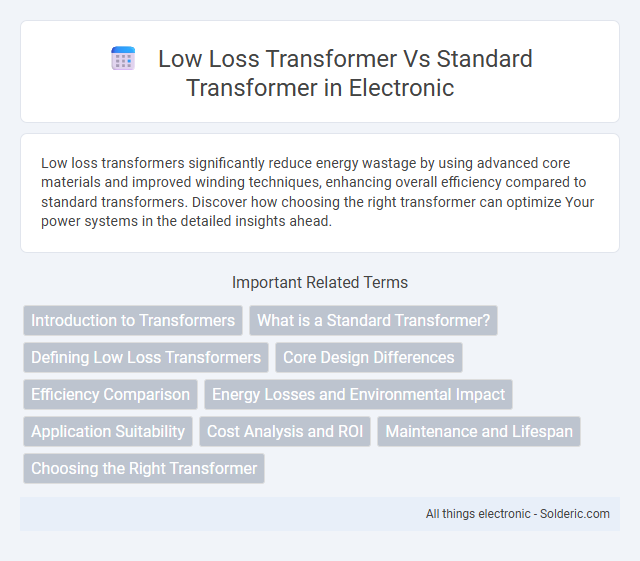Low loss transformers significantly reduce energy wastage by using advanced core materials and improved winding techniques, enhancing overall efficiency compared to standard transformers. Discover how choosing the right transformer can optimize Your power systems in the detailed insights ahead.
Comparison Table
| Feature | Low Loss Transformer | Standard Transformer |
|---|---|---|
| Core Material | High-grade silicon steel or amorphous steel | Regular silicon steel |
| Energy Efficiency | Up to 98-99% efficiency | Typically 95-97% efficiency |
| Core Losses (No-load losses) | Significantly reduced (20-50% lower) | Higher core losses |
| Load Losses | Minimal reduction compared to standard | Standard load losses |
| Operating Temperature | Lower due to reduced losses | Higher operating temperature |
| Lifespan | Longer due to improved design and materials | Standard lifespan |
| Initial Cost | Higher investment | Lower initial cost |
| Typical Applications | Energy-sensitive projects, renewable energy, grid optimization | General power distribution and industrial use |
Introduction to Transformers
Transformers are electrical devices that transfer electrical energy between two or more circuits through electromagnetic induction with minimal energy loss. Low loss transformers use advanced materials and design techniques such as amorphous steel cores and optimized winding configurations to reduce core and copper losses compared to standard transformers. This results in higher efficiency, reduced heat generation, and lower operational costs in electrical power distribution and industrial applications.
What is a Standard Transformer?
A standard transformer is an electrical device that transfers electrical energy between two or more circuits through electromagnetic induction, commonly used to step voltage up or down in power systems. It typically features laminated steel cores and copper windings, which result in inherent energy losses due to resistance and magnetic hysteresis. These losses manifest as heat, reducing efficiency compared to low loss transformers designed with advanced materials to minimize energy dissipation.
Defining Low Loss Transformers
Low loss transformers are designed to minimize energy dissipation by using high-quality magnetic materials and advanced core construction techniques. They achieve significantly lower core and copper losses compared to standard transformers, improving energy efficiency and reducing operational costs. Your power systems benefit from enhanced reliability and sustainability when utilizing low loss transformers.
Core Design Differences
Low loss transformers feature advanced core designs using high-grade silicon steel or amorphous steel materials that minimize hysteresis and eddy current losses, whereas standard transformers use conventional grain-oriented steel cores resulting in higher energy dissipation. The core geometry in low loss transformers is optimized for reduced magnetic flux leakage and lower core saturation, improving efficiency and thermal performance. You benefit from significantly reduced energy waste and improved operational longevity with low loss transformer cores compared to standard designs.
Efficiency Comparison
Low loss transformers exhibit significantly higher efficiency than standard transformers by utilizing advanced core materials and optimized winding designs that reduce hysteresis and eddy current losses. These transformers typically achieve efficiency improvements of 1-3% under full load conditions, resulting in substantial energy savings over their operational lifespan. Enhanced efficiency not only reduces electricity costs but also lowers heat generation, contributing to improved reliability and extended service life.
Energy Losses and Environmental Impact
Low loss transformers significantly reduce energy losses by using high-quality magnetic materials and optimized core designs, resulting in improved efficiency compared to standard transformers that typically experience higher core and copper losses. This reduction in energy waste not only lowers operational costs but also decreases greenhouse gas emissions associated with electricity generation, benefiting the environment. By choosing a low loss transformer, your electrical system supports sustainable energy consumption and contributes to reducing the carbon footprint.
Application Suitability
Low loss transformers are ideal for applications requiring high energy efficiency and minimal heat generation, such as renewable energy systems, industrial automation, and data centers. Standard transformers are suitable for general-purpose use where cost efficiency is prioritized over energy savings, including residential and commercial electrical distribution. You can optimize your system's performance by selecting a transformer type that aligns with your specific operational and efficiency requirements.
Cost Analysis and ROI
Low loss transformers typically have higher upfront costs due to advanced core materials and design optimizations but offer significant reductions in energy losses, resulting in lower operational expenses. The return on investment (ROI) for low loss transformers is often favorable within a few years, especially in applications with continuous or high load operation where energy savings accumulate rapidly. Standard transformers may have lower initial costs but accrue higher lifetime costs through increased energy losses and maintenance, making low loss transformers more cost-effective over the asset lifecycle.
Maintenance and Lifespan
Low loss transformers require less frequent maintenance due to their advanced core materials and improved insulation, which reduce overheating and minimize wear. Standard transformers often need more regular inspections and servicing to manage higher losses and increased thermal stress. Choosing a low loss transformer can extend your equipment's lifespan, ensuring more reliable performance and lower total cost of ownership.
Choosing the Right Transformer
Selecting the right transformer hinges on balancing energy efficiency and cost-effectiveness; low loss transformers significantly reduce core and copper losses, making them ideal for applications requiring continuous operation and minimal energy waste. Standard transformers, while generally more affordable upfront, exhibit higher energy losses, leading to increased operational costs over time in high-demand environments. Evaluating load profiles and long-term savings helps in determining whether a low loss transformer's initial investment aligns with the project's efficiency goals and sustainability requirements.
low loss transformer vs standard transformer Infographic

 solderic.com
solderic.com